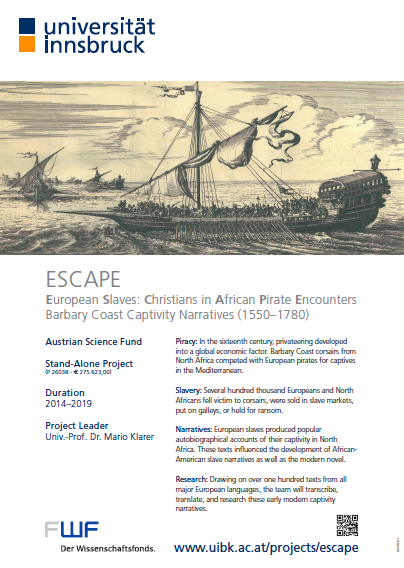European Slaves:
Christians in African
Pirate Encounters

News
Lecture “Piraterie, Korsarentum und Sklaverei: Der frühneuzeitliche Kaperkrieg auf dem Mittelmeer” at the Volkshochschule Zürich on May 16, 2023.
Book talk of Barbary Captives: An Anthology of Early Modern Slave Memoirs by Europeans in North Africa at the Columbia Global Centers Tunis on January 6, 2023.
Radio feature
"Versklavt im Mittelmeer – Als Christen und Moslems sich jagten," radioWissen, Bayern 2, September 12, 2022.
Review of Barbary Captives: An Anthology of Early Modern Slave Memoirs by Europeans in North Africa in Goodreads.
Newspaper article
“Vom Sklaven zum Bestsellerautor,” Die Presse, July 23, 2022.
Publication of Barbary Captives: An Anthology of Early Modern Slave Memoirs by Europeans in North Africa by Columbia University Press.
Review of Verschleppt, Verkauft, Versklavt: Deutschsprachige Sklavenberichte aus Nordafrika (1550–1800). Edition und Kommentar in Monatshefte.
Review of Mediterranean Slavery and World Literature: Captivity Genres from Cervantes to Rousseau in sehepunkte.
Review of Piracy and Captivity in the Mediterranean: 1550–1810 in sehepunkte.
Review of Verschleppt, Verkauft, Versklavt: Deutschsprachige Sklavenberichte aus Nordafrika (1550–1800). Edition und Kommentar in sehepunkte.
Review of Piraten und Sklaven im Mittelmeer: Eine Ausstellung von Schloss Ambras Innsbruck und der Universität Innsbruck in sehepunkte.
Review of Verschleppt, Verkauft, Versklavt: Deutschsprachige Sklavenberichte aus Nordafrika (1550–1800) in Historische Zeitschrift.
Review of Verschleppt, Verkauft, Versklavt: Deutschsprachige Sklavenberichte aus Nordafrika (1550–1800) in H-Soz-Kult.
Online article
"Ein weißer Sklave macht Karriere," RP Online, November 13, 2020, online.
Radio feature
"Diagonal zum Thema: Sklaverei," Ö1, February 29, 2020.
"Das Inhaltsverzeichnis," 4:28 min.
"Deutschsprachige Sklavenberichte aus Nordafrika," 5:01 min.
Online article
"Vormoderne Sklaverei am Mittelmeer", science.ORF.at, December 6, 2019, online.
Newspaper article
"Piraten lockten 50.000 Besucher nach Ambras", Tiroler Tagezeitung, September 11, 2019.
Online article
Piraterie und Sklaverei: Auf Menschenjagd im Mittelmeer, Der Standard, July 2, 2019, online.
Newspaper article
"Wie ein Tiroler Bauer von Piraten versklavt wurde", Tiroler Tageszeitung Magazin, July 15, 2018.
Newspaper article
"Menschenhandel im Mittelmeerraum", Die Presse, June 9, 2018.
Lecture
Robert Spindler (Innsbruck), "Renegados: Converted Christians in British Barbary Captivity Narratives", International Symposium Buccaneers, Corsairs, Pirates and Privateers: Connecting the Early Modern Seas, Bielefeld University, 13.04.2018.
Lecture
Robert Spindler (Innsbruck), "Three Early Modern Barbary Captivity Narratives in the German Language and their Portrayal of Islam", Mediterranean Collaborative, Consortium for the Study of the Premodern World at the University of Minnesota, 08.11.2017.
Lecture
Robert Spindler (Innsbruck), "Masters, Agusins and Renegados: Portrayals of Muslims in Early Modern Barbary Captivity Narratives from Germany and Austria", SAGES Program, Case Western Reserve University in Cleveland, Ohio, 04.11.2017.
Newspaper article
"Auf zum Entern!", Der Standard.
Lecture
Robert Spindler (Innsbruck), "Merckwürdige Lebens- und Reisebeschreibung: Der Bericht des Johann Michael Kühn", Erzählen zwischen Fakt und Fiktion (workshop), Innsbruck, 23.02.2017.
Article
German article about our conference on "Piracy and Captivity in the Mediterranean: 1530-1810" in Innsbruck.
Newspaper article
"Als christlicher Gefangener unter Piraten", Der Standard.
Contact us:
Mario Klarer
Principal investigator
Telephone:
+43 512 507 4172
Email:
mario.klarer@uibk.ac.at
Mail:
Institut für Amerikastudien
Universität Innsbruck
Innrain 52d
6020 Innsbruck
AUSTRIA

Supported by a grant from the

City Descriptions in Barbary Coast Captivity Narratives
by Robert Spindler
Abstract
The individual experiences of the countless European and American sailors, merchants, soldiers, and civilians who fell victims to Barbary Coast pirates between the 16th and early 19th century differed greatly. Some captives were literally enslaved and forced to do hard physical labor, others persevered under relatively comfortable conditions awaiting their ransom. A considerable number were also gradually integrated into the culture of their captors and managed to pursue a formidable career in North Africa. Those who eventually returned to their home countries, whether through escape or release, and whose captivity experience was written down either by themselves or someone else, had become keen observers of their new exotic surroundings. Besides depictions of the North African flora and fauna, descriptions of cities and their walls, houses, fortifications and inhabitants are a standard feature of most Barbary Coast captivity narratives.
Including such an urban topography in a captivity narrative could serve a number of purposes. The information was useful for military purposes, as it could reveal strengths and weaknesses of a city's fortifications and indicate strategical points for a potential attack or conquest. It also served the purpose of the author, for example by denigrating or vilifying Muslim culture and depicting captivity conditions as particularly harsh. And not at last, it served the curiosity for the exotic in readers of the broad public. In this way, the city descriptions also contributed to a contorted, romanticized, and hybridized Western view of Eastern culture, a concept which was notably discussed by Edward Said in his book Orientalism and is still perceptible in the literature, art, and architecture of the West.
The city descriptions in Barbary Coast captivity narratives can take as different shapes as the experiences of the captives, but they can also follow topical schemes. In this paper, I will take a close look at various city descriptions in European and American Barbary Coast captivity narratives and analyze them with such aspects as purpose, authenticity, readership, effects, etc. in mind. A particular focus will be put on the interesting case of the capture of the crew of the Philadelphia in the course of the Tripolitan War of 1801-05, which is documented in three contrasting captivity narratives, all featuring distinct descriptions of the city of Tripoli.



